39. Solve bird problems carefully, responsibly, and proactively.
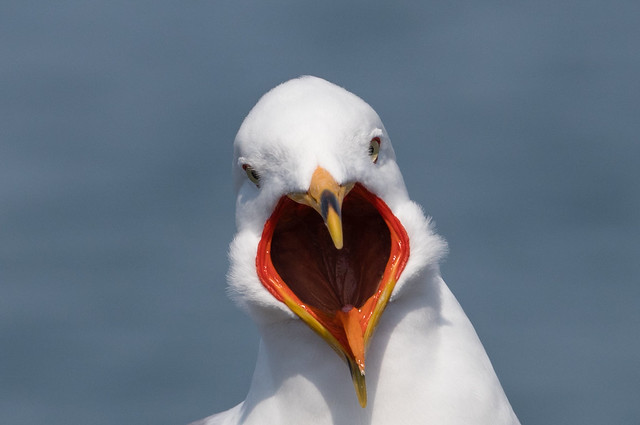
No matter how devoted to birds you are, in some situations, birds can cause problems. Finding safe and humane ways of dealing with these issues is important for our own peace of mind as well as for the birds. Bird problems are as varied as birds themselves.
Herons, pelicans, eagles, osprey, cormorants, and kingfishers compete with humans for fish, which can make them unpopular. Fish declines attributable to birds are only a tiny fraction of those due to habitat degradation, pesticides, manure and other nutrient runoff, mercury and other toxins, power plants, shoreline erosion, commercial and even sport fishing, and dams, but birds make an easy scapegoat. Every year the U.S. Department of Agriculture’s Animal and Plant Health Inspection Service issues permits allowing farmers and fish farmers to kill millions of migratory birds. In Washington state, where salmon are endangered due to devastating habitat degradation from dams, unsustainable forestry practices, and erosion, permits are issued to kill thousands of migratory birds each year, including herons, ducks, gulls, grebes, and cormorants. Yet little is done to address the root causes of salmon declines, and there is no research-based evidence that birds have any effect whatsoever on the return of adult salmon. According to an Arkansas Times article by Leslie Newell Peacock (August 5, 2004), a single Arkansas fish farm owner was given permits to kill 400 Great Blue Herons, 400 Great Egrets, 100 American Coots, 100 American White Pelicans, and 5 Snowy Egrets in 2004 alone.
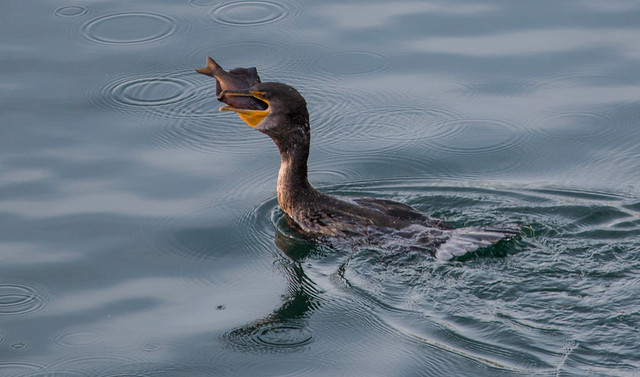
Research by the U.S. Department of Agriculture (USDA) found that cormorants have little or no effect on sport fish, choosing gizzard shad and yellow bass over largemouth bass and crappie. Although they have a more serious effect on catfish, another USDA study found that a nonlethal method to reduce cormorant fishing on catfish ponds was “cost-efficient and easy to set up.” Cormorants are killed not only when they are actually causing problems; adults and babies are killed in their nesting trees, often many miles from any fish farms. In the 1970s, the Double-crested Cormorant was listed as a threatened species in many places. But since then, both pelican and cormorant populations have surged, partly because they’ve recovered from the effects of DDT, and partly because of the subsidies humans provide at poorly designed fish hatcheries and fish farms. Bird populations, like sunlight and rainfall, are natural situations that fish farmers need to accept and adapt to as part of their cost of doing business. There are effective, nonlethal methods of reducing bird predation on fish farms, and managers should use them.
Fish farmers aren’t the only ones who don’t want to share fish with birds. In Duluth one spring, I received many phone calls about a Great Blue Heron that was fishing on the banks of a local river, side by side with human fishermen. Sometimes the heron would approach someone who’d just caught a fish, and sometimes the bird actually took fish from the fishermen’s buckets. Most of the anglers were charmed rather than annoyed. Then, after a few weeks, one fisherman clubbed the bird to death, an offense that isn’t just cruel and wrong but also illegal. Unfortunately, he got away with it because none of the witnesses could or would identify him. Sportfishermen don’t always appreciate avian competition, but birds are an important natural resource, too. People who are concerned about declining fish populations need to look at the root causes rather than blaming birds.
That said, some conflicts between cormorants and people are based on real problems. Large cormorant populations are associated with habitat alteration at nest colonies, which can lower property values and affect other colonial waterbirds. In addition, it can lead to vast accumulations of guano on ships, buildings, breakwaters, and other waterway structures; nutrient overload that lowers water quality; and possible transmission of fish diseases or parasites. Although cormorants eat a lot of “rough fish,” their take of other species can be significant. Studies indicate that although cormorants usually have only small impacts on fish populations, local impacts may be significant. For example, smallmouth bass constitute less than 2 percent of a cormorant’s total diet, but this amounts to about 21 to 35 percent of the bass available in the Eastern Basin of Lake Ontario. When departments of natural resources try to balance the needs of all their constituencies, they sometimes make the decision to harass or even kill cormorants. Once this decision is made, the best approach for bird lovers is to encourage them to choose the safest and most humane methods to at least minimize potential environmental harms and undue suffering.
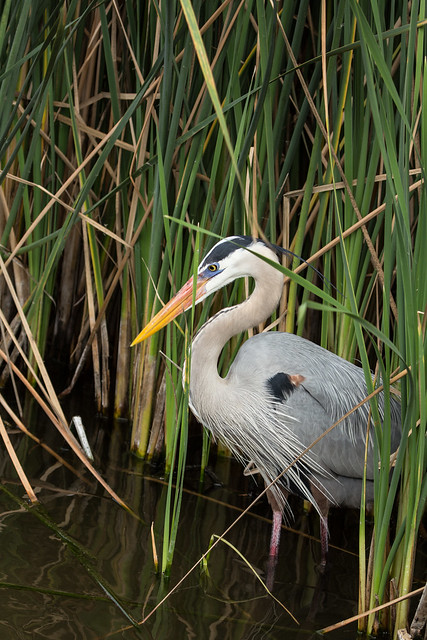
People who raise koi and other exotic fish in small backyard ponds understandably get annoyed when Great Blue Herons and other birds fly in and eat their fish. Since the whole purpose of these ponds is aesthetic, it doesn’t make sense to cover them with nets. The most effective way to protect them is to design the pond to deter birds. Herons fish from a standing position, so they need fairly shallow water. Deep water and steep banks will protect fish from them. If the pond surface area is small, you don’t need to worry about attracting cormorants and loons, which need running space to take off. The possibility of these exotic fish introducing exotic diseases into a natural system is a problem that most backyard fish owners don’t fully appreciate.
Unlike most birds, Canada Geese can digest grass, making their droppings particularly unpleasant. Since geese learn how to negotiate life from their parents rather than doing most things by instinct, some geese have adapted to living near people, cars, and buildings. These birds have increased and multiplied, and their many offspring know no other life. Large flocks often gather on lawns near lakes, rivers and streams—an unnatural habitat that increases the likelihood that their droppings will run off into the water.
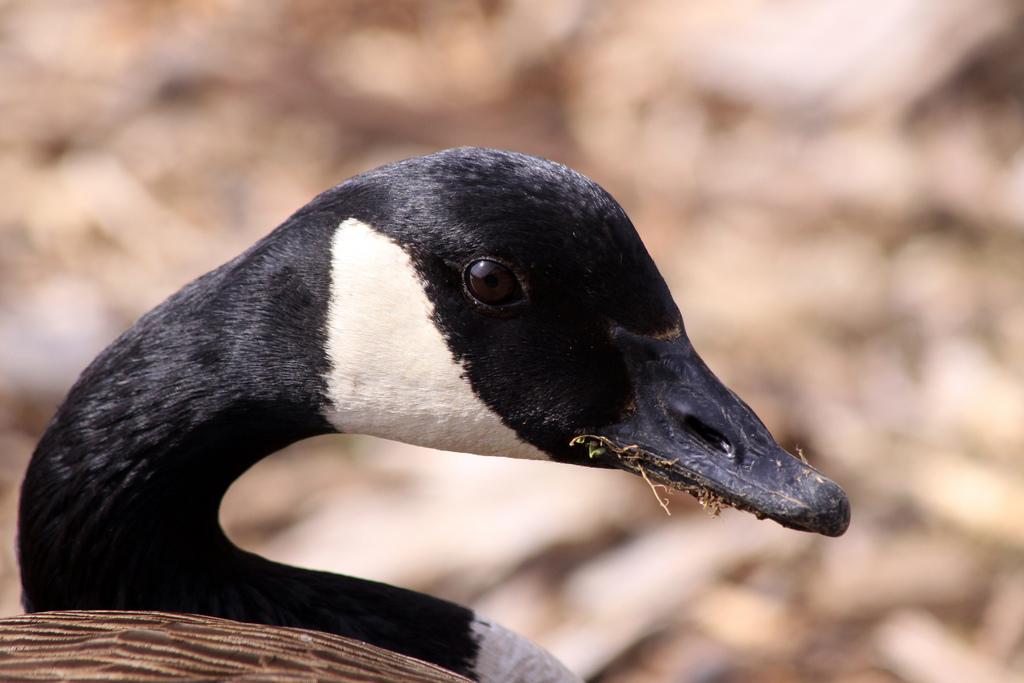
Less serious environmentally, but still a nuisance, are geese gatherings on golf courses, church lawns, and residential lawns. The obvious long-term solution is to replace unnatural turf with natural vegetation, but that won’t work on golf courses. Some people lay down green plastic mesh where they have a goose problem. The geese seem to dislike the feel of this and go elsewhere; again, this isn’t practical for golf courses. Probably the most effective way of discouraging geese from invading areas such as golf courses and airports is to use trained dogs. Obviously, you can’t have dogs running around a golf course all day long while people are trying to play, but if a handler runs the dogs every morning and evening for an hour at first and last light when the geese are building their nests, this may encourage them to nest elsewhere. But the problem with exploding populations, whether they are deer, geese, or humans, is that eventually, all the elsewheres become filled, too. Not until we get over our obsession with monoculture lawns will we even begin to solve the goose overpopulation problem.
Once in a while, home owners get upset or frustrated by hawks, owls, or shrikes visiting a feeding station to pick up an easy meal. Some people enjoy watching these birds and simply make sure that there are enough hiding places near feeders to protect alert songbirds. One year, a Merlin nested on my block and appeared in my yard just about every day, but at different times. It would cruise down the street just above the sidewalk, dropping to within a foot or less of the ground as it passed my house. Then it would wheel around a spruce tree in the corner of my front lawn at high speed, completely hidden from the view of birds at the feeders in the side yard, until it was within striking distance. The songbirds would scatter, but at least half the time the Merlin would be successful and grab one. As hard as this was on the individual birds the Merlin took, and as sad as it made me at times, the Merlin pair raised two chicks and then moved on, and they haven’t nested on my block since. Like all creatures, Merlins are just trying to make their way in the world.
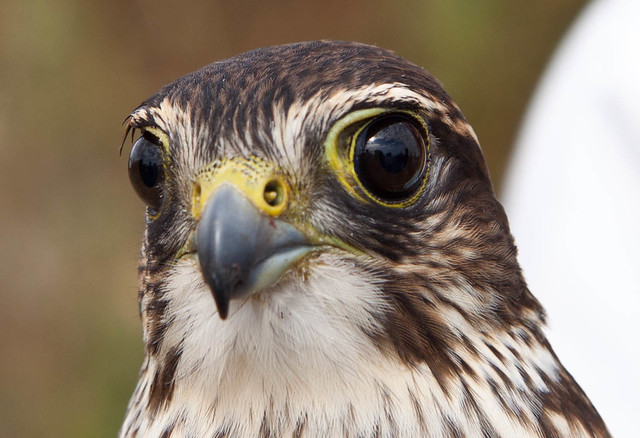
If a raptor’s daily visits are upsetting, you might want to close down the feeder for a week or so to break the habit. Otherwise, it’s just as well to assume a Zenlike attitude toward birds of prey, which are fully protected by state and federal laws. If their killing ways disturb you, remember that even bluebirds are considered vicious serial killers by insects.
Like other birds undergoing population explosions, gulls, especially Ring-billed Gulls, are exploiting the many new sources of food provided in the urban and suburban environment—easily available garbage, various invertebrates living in our expansive lawns, and handouts from people. Until we stop subsidizing them and maintaining huge areas of turf, the gull problem will remain serious. The overpopulation of gulls, like that of crows, causes ecological problems because gulls take so many eggs and chicks of terns, plovers, and other shorebirds. On foggy mornings during migration, I’ve watched Ring-billed Gulls in Duluth snapping up warblers in midair as the exhausted little migrants dropped down after the night’s flight. Leaving dog food where birds can find it and feeding bread at feeders exacerbates the gull problem. Beautiful as they are, gulls simply do not need subsidies from us.
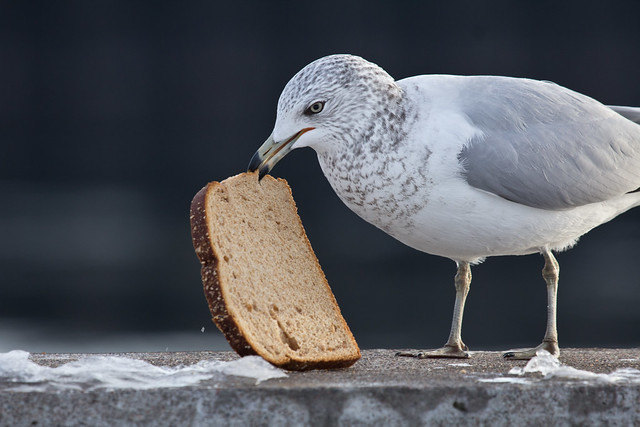
Gulls and a wide variety of other birds can pose a serious problem at airports. Damage to US. civil and miltary planes costs more than $600 million annually. Bird-plane collisions also put the lives of aircraft crew members and passengers at risk. More than 195 people have been killed worldwide as a result of aircraft strikes since 1988. Since 1975, five large jet airliners have had major accidents in which bird strikes played a significant role. In one case, about three dozen people were killed. The horror of human beings dying eclipses the environmental destruction, but that too is an element of bird-plane collisions. As a result of a bird strike that disabled an engine on a B-747 departing Los Angeles International Airport in August 2000, the pilot had to dump eighty-three tons of fuel over the Pacific Ocean before returning to land safely.
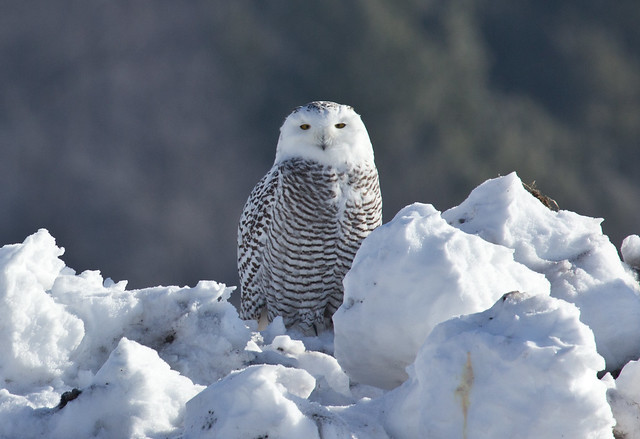
There are a number of effective techniques that can reduce the number of birds in the vicinity of airports. In general, the techniques fall into three categories:
1.Make the environment unattractive for birds, which may involve draining a swamp, getting rid of a prairie dog colony that provides food for predator birds, or simply cutting the grass.
2.Scare the birds away. This can sometimes be accomplished with pyrotechnics and fireworks or remote-controlled aircraft. Airfield managers must continue to use these techniques, however, or the birds will quickly return. Birds often learn to cope with loud noisemakers, figure out that owl decoys are fakes, and ignore scarecrows.
3.Reduce the bird population. As a last resort, sometimes airports must shoot birds that won’t leave. They have to get permits to kill most species and can’t harm endangered animals.
One extremely effective way of keeping birds away from airports (and golf courses) and minimizing environmental damage is to employ border collies to chase them away. These intelligent working dogs are tireless and responsible and so effective that one Florida airport was bird free within two months of hiring a dog and handler.
ADDED AFTER BOOK PUBLICATION: People involved in Massachusetts Audubon’s Snowy Owl Project keep track of appearances of Snowy Owls at Logan International Airport, band the birds and affix transmitters, and remove them from the airport. This provides a lot of valuable information about the species while also helping prevent collisions between the birds and aircraft. Also, many airports now hire falconers whose trained birds scare off airport birds, sometimes even more effectively than dogs.
Rock Pigeons were one of the first species introduced to North America by European settlers, who brought the birds here for food and to raise as pets, racers, and messengers. Although pigeons weren’t intentionally introduced to the wild, feral populations quickly became established. Unlike most introduced species, pigeons have invaded very few natural habitats, don’t compete with native birds for natural food or nesting sites, and provide a lot of entertainment and pleasure in urban habitats. Pigeons have saved thousands of human lives by carrying important messages in wartime and blood samples from hospitals to laboratories in peacetime. And they serve as a reliable food source for reintroduced Peregrine Falcons, especially in urban areas. Rock Pigeons are similar in size to the now-extinct Passenger Pigeons, which once formed a significant prey base for peregrines.
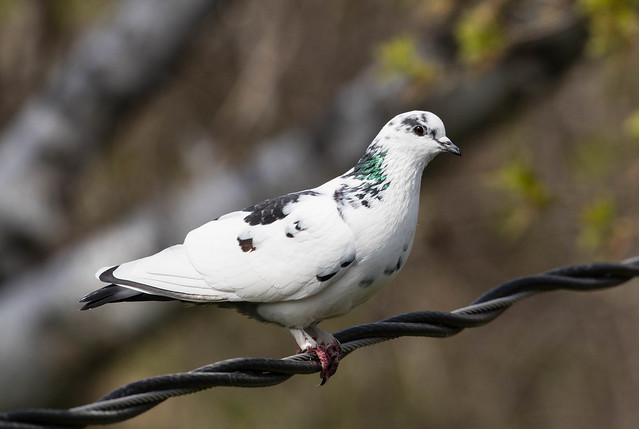
Unfortunately, pigeons can sometimes be a nuisance and occasionally pose a health hazard where they are exceptionally numerous or are nesting in enclosed quarters where their droppings collect. When they gather at grain elevators and railroads, they feed on spilled seeds, seldom posing a serious economic problem, although that spilled grain also attracts rats and mice, which can be harmful.
There is no situation in which a pigeon infestation requires poison with anticoagulants. Pigeons virtually never pose ecological problems, and although old, moldy roost sites can definitely cause health problems, cleaning and sealing them off does not require killing the birds, especially with dangerous toxins. The avicide Rid-A-Bird and other pesticides with fenthion are no longer legal, for good reason. Under no circumstances should fenthion ever be used, since it is utterly indiscrimminate in the birds it kills, and the toxin in just a single bird killed by fenthion can be enough to kill a bird of prey or scavenger feeding on the carcass.
Tanglefoot and other nontoxic sticky coatings used to keep pigeons off eaves and other structures may temporarily deter them, but at a huge cost. Animals aren’t scared away by it—they’re coated with it, and it causes undue suffering to any bird or mammal that happens to come in contact with it. If an animal gets stuck, it may bite off its legs in order to escape. If it does escape intact with Tanglefood on its body, it’s unlikely to survive. Tanglefoot is not water soluble, and it destroys the waterproofing of fur or feathers. To repair just one Red-tailed Hawk coated with the substance, Scott Diehl, manager of the Wisconsin Humane Society Wildlife Rehabilitation Center in Milwaukee, had to anesthetize the bird three times for special cleanings.
To keep unwanted pigeons from roosting and nesting in attics and on eaves and other structures, close off entryways. To dissuade them from roosting in areas that don’t lend themselves to being sealed off, helium balloons can be effective. Birds are often frightened by the balloons’ unexpected movements, since nothing they encounter in the natural world “falls up.” Brightly colored Mylar balloons are scary enough so that by the time the helium has leaked out, the pigeons have usually found other roosting places. Plastic owls and snakes may work temporarily, but birds are smarter than people give them credit for and quickly figure out that these are fakes. Gluing loose feathers on an owl decoy or getting one with a movable neck joint may succeed a bit longer, but local birds will eventually learn that they can safely ignore it.
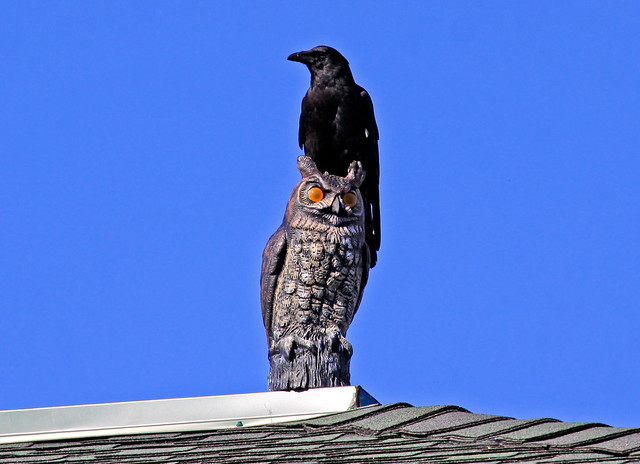
In some communities, pigeons are controlled by providing attractive pigeon nest boxes. Then, when the eggs have been laid, people switch them with wooden decoy eggs to limit reproduction. This method requires vigilance and man-hours, but it is actually much easier and cheaper than conscientiously searching out dead and dying pigeons after using poisons.
Woodpeckers can be annoying when they bang on your downspout at five in the morning, or they can cause more significant damage by digging holes in your cedar siding. To deal with them, you need to figure out what they’re doing.
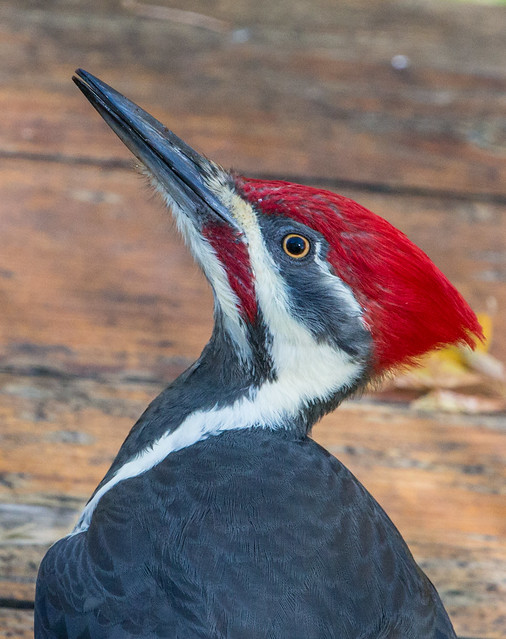
Woodpeckers “drum” to advertise their territory, and the choose the noisiest, most resonant percussion instrument they can find, because the farther the sound carries, the wider their territorial boundaries. According to the Cornell Lab of Ornithology, woodpeckers drum on aluminum siding; the trim boards and fascia boards of wood, brick, and stucco houses; and metal downspouts, gutters, chimneys, and vents. Birders often get a kick out of listening to woodpeckers, but if the noise is too bothersome, you can temporarily cover the area they’re hammering on with insulation or a towel to send them elsewhere.
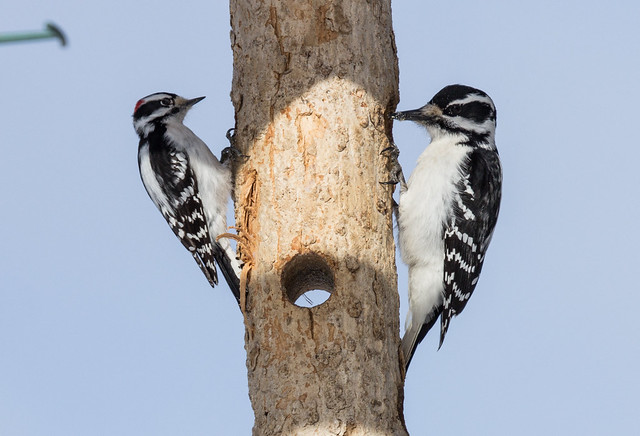
Woodpeckers hoping to roost or nest in your house can cut fairly large holes into the wood. They are most likely to attempt to dig out holes when your house is in a wooded area and is sided with natural or dark-stained wood. Most attractive for them, according to the Cornell Lab, is clapboard siding, board-and-batten siding, tongue-and-groove siding, and, less often, resawn shakes and shingles. Woodpeckers are most drawn to redwood and cedar. When beginning to drill nesting or roosting holes, woodpeckers often make several attempts, starting a hole in one spot and then starting a new one. This is how a single house can end up with so many large holes. Woodpeckers are most quiet when probing for insects within the siding. In these situations, they can leave dozens or even hundreds of tinier holes.
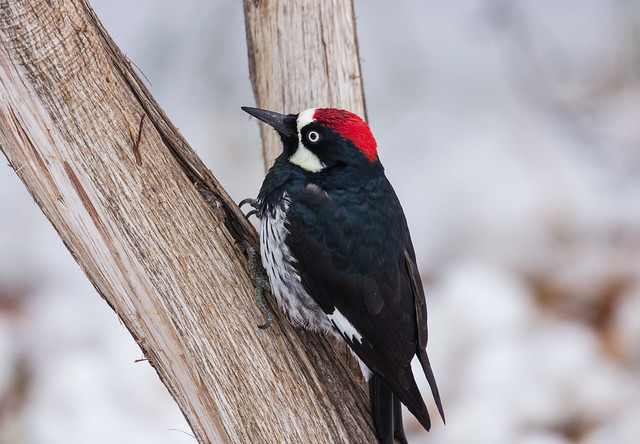
In the West, Acorn Woodpeckers sometimes gouge a huge number of holes in a building, into which they stuff acorns for storage. Some people in sturdy houses laugh this off or enjoy the rustic look, but many people are not amused.
So what can you do about woodpecker damage? Removing woodpeckers by trapping or even shooting virtually never works, because whatever attracted the first bird will quickly attract another one. Tanglefoot and other sticky coatings stain the wood and cause serious problems for wildlife without preventing future problems—a cruel and shortsighted answer that is unwarranted in this situation.
Here are some recommendations:
- Repair every woodpecker hole as soon as possible. Aluminum flashing can be used to cover existing holes or to line the corner or fascia boards of the house. You can paint it to match the color of your siding.
- Hang aluminum foil strips, brightly colored reflective tape, or windsocks down from above or helium balloons up from below. Bright pinwheels near the damage may help, too. Woodpeckers may also be dissuaded by owl decoys with moving parts or recordings of hawks.
- Lightweight nylon or plastic netting can be attached from over-hanging eaves to the siding of the damaged building. One type of netting is called BirdNet, manufactured by Bird-X. To keep the birds from reaching through the net, leave at least three inches between the net and the siding.
- Provide plenty of suet feeders. These may entice woodpeckers away from your house if they are hunting for insects. Unfortunately, suet may attract more woodpeckers to your property, some of which might then discover your house.
- As long as a nest is not already established, roost or nest holes should be plugged with wood putty during the daytime. If the birds already have eggs or young, the holes can be sealed after the nestlings have fledged, usually by midsummer. If you act as soon as you notice woodpecker damage, they will be dissuaded before the cavity is constructed.
- If woodpeckers are poking into the holes of carpenter bees, get rid of the bees. These insects prefer either natural or stained wood: wood that is painted (oil base or polyurethane) is less likely to be infested, because the hard finish deters bees. If you prefer natural or stained wood, the Cornell Lab recommends spraying the area with a preventative insects control such as Cypermethrin; if the bees are already established, consider using an insecticide specifically designed to control wasps and bees. It should be sprayed into the entrance holes in late evening or at night when the bees are inside the tunnels. After twenty-four hours, plug the tunnel entrances with cork, a wooden dowel, or wood putty to keep bees from recolonizing.
- If your house is sided with grooved plywood, the Cornell Lab recommends painting it to seal core gaps and prevent insects from tunneling into the wood. Alternatively, caulking along the sides of the vertical grooves will cover entrances to gaps in the core. Once the gaps are caulked, repair the damage to the old holes don’t attract foraging woodpeckers.
- For houses sided with wooden shakes, shingles, or board and batten, the Cornell Lab recommends hiring an exterminator to spray the outside of the house with insecticide and then replacing the damaged shakes or boards. Once the insects are gone, the woodpeckers won’t be attracted.
- In the case of Acorn Woodpecker damage, sealing every hole and then covering the area with hardware cloth or plastic netting should solve the problem.
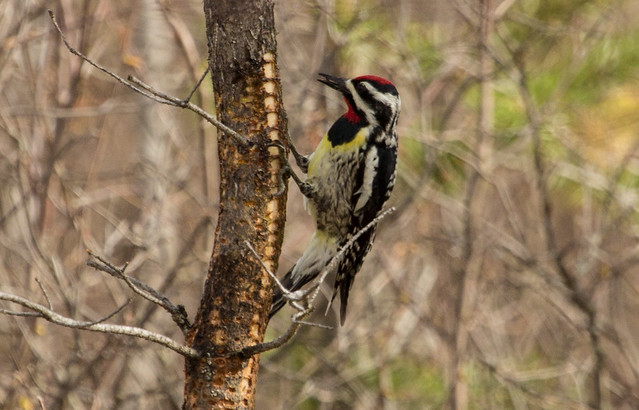
Sapsuckers probing for sap are the only woodpeckers that regularly dig into healthy tree tissue. Sap running from their drill holes provides one of the chief natural foods for the first hummingbirds that arrive before flowers bloom in the spring. The sap also feeds a wide variety of warblers, flycatchers, kinglets, and other songbirds and seldom does permanent damage to the tree. But in the event that a sapsucker is tapping a prized ornamental tree, wrapping aluminum sheeting or burlap around the area is nearly always effective.
Phoebes and swallows nesting on houses annoy some people who don’t like the messy mud nests, don’t appreciate the droppings below the nests, and don’t like being attacked by protective parent birds. These birds eat flying insects, including mosquitoes, almost exclusively, giving tolerant people a practical bonus, and their graceful flight is wonderfully entertaining. If you can’t tolerate their nests, you need to be proactive, washing down the mud the moment it appears—before the nest is built and the first eggs laid—and then putting up helium balloons or covering the area with plastic to prevent future building. Building a nest shelf in a more acceptable area of the house or garage can solve the problems for you while accommodating the needs of the birds.
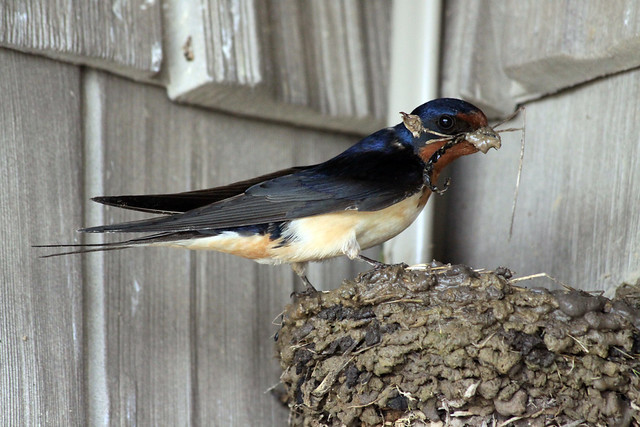
Blue Jays and Steller’s Jays often raid the nests of other birds, especially robins. I’ve watched Blue Jays do this on many occasions, and in every case, the jay was an adult that carried the “plunder” off to feed its mate or nestlings. Jays typically raise five babies a year in a single clutch, and it takes only fourteen to eighteen days for baby jays to fledge at close to their full adult weight, so parent jays need to find a lot of protein-rich food during this brief nesting period. Once the babies are full grown, their diet becomes typical of adult Blue Jays; the vast majority consists of vegetal matter (especially acorns and other mast, along with berries and seeds), with most of the animal matter in the form of insects and, at feeders, suet. But at all times, jays are opportunistic omnivores.
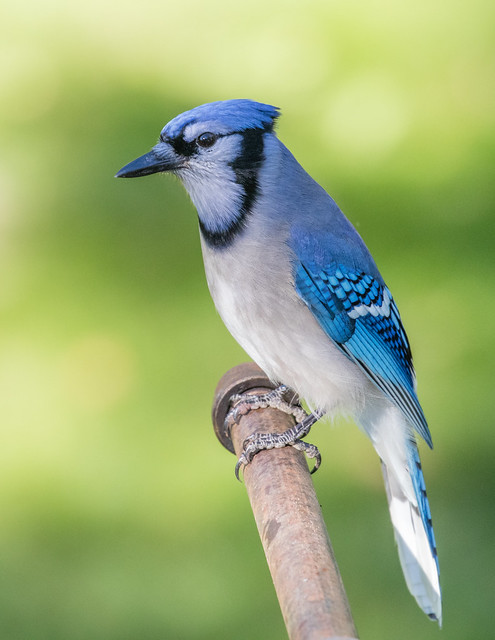
When jays fly into a feeding station, often all the other birds fly off. After observing this pattern for many years, I’ve concluded that it’s because jays have a silhouette similar to that of a Sharp-shinned Hawk, with rounded wings and a long, narrow tail. Birds who wait to verify an identification before flying off aren’t likely to survive very long. But once skittish birds see that it’s just a jay, they quickly return.
Jays are noisy, and although we may find that annoying, other birds appreciate it because the jays are so effective at warning the whole avian neighborhood about predators and other danger. If you don’t want jays visiting your feeders, however, try using hanging feeders.
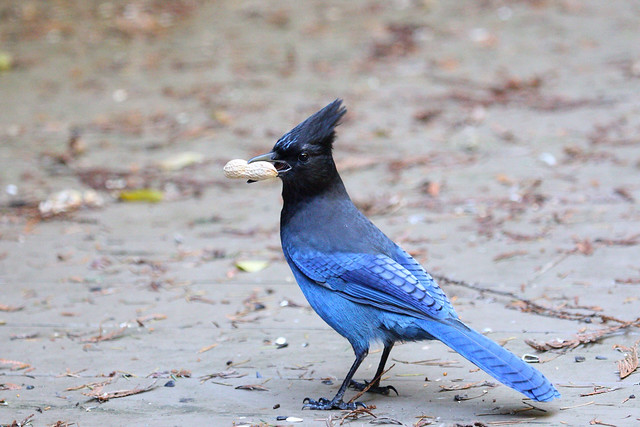
Blue Jays are found in just about every habitat as long as there are some shade trees, and their population isn’t increasing. As a matter of fact, Breeding Bird Survey data show a slight but significant decline in Blue Jay numbers across the United States, with most of the decline in the East. Steller’s Jays are merely holding their own. As with hawks, if you can’t learn to appreciate jays, adopting a Zenlike attitude toward them will at least save you some irritation.
The American Crow belongs to the same family as jays, but unlike its diminutive relatives, its population has exploded. Crows have learned to exploit dumpsters and garbage bags, dog kennels, gardens, roadsides, and birds smacking into windows and communications towers for food. In cities, where shooting is prohibited, crows don’t have to worry about their two biggest population-limiting factors—hunting and winter food availability. When provided with a high-quality diet year-round, along with large spruce trees for nesting in established neighborhoods, how could crows help but thrive? Unfortunately, crows can annoy us with their raucous caws, and they take a large number of songbird eggs and nestlings—far more than jays, because crow babies are much larger and require more protein to reach full size. In my neighborhood in Duluth, I haven’t seen a single robin pair fledge young from any tree nest in ten years. Because crows are so abundant and observant, virtually all the successful robins in my area now nest on window ledges, basement window wells, or porch lights. Several people have told me that in the Twin Cities, crows are even learning to raid robin nests on houses.
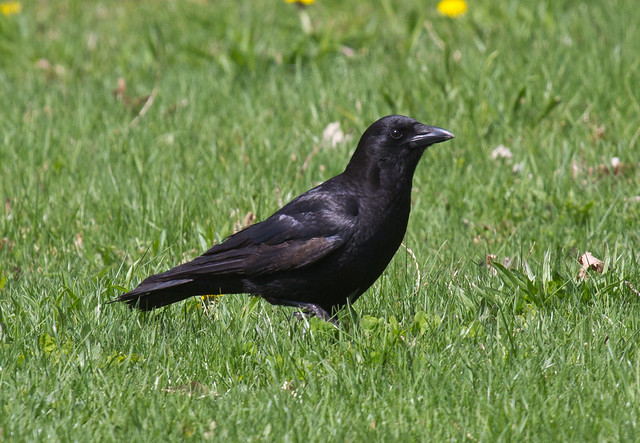
In other areas, crow populations have been decimated or even extirpated by West Nile virus. Although that disease has killed birds belonging to hundreds of species, crows are uniquely vulnerable. In laboratory studies, 98 to 100 percent of crows exposed to any amount of the virus die. Because of their large size and conspicuousness, dead and dying crows serve as an important warning of where West Nile is spreading. It’s possible that the disease will reduce crow numbers throughout the continent, but eventually, resistant populations will reestablish.
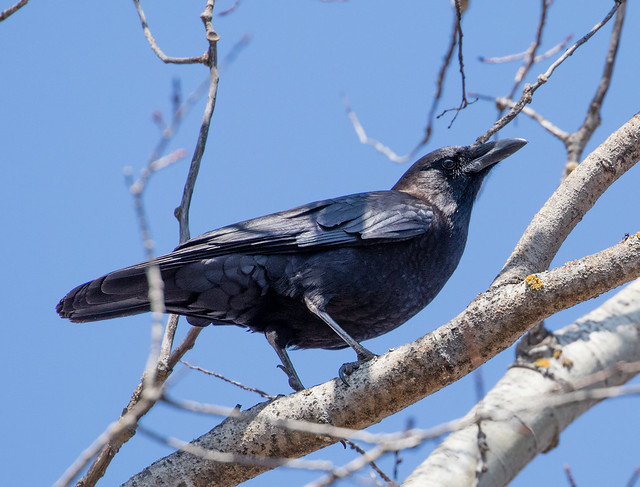
The crow problem arose because our current urban and suburban lifestyle subsidizes them. Crows, like humans, are intelligent, opportunistic omnivores with fascinating, complex social structures. Henry Ward Beecher wrote that if men could fly and bore black feathers, few would be clever enough to be crows. Problems with crow overpopulation will continue in many areas until we learn to keep our garbage sealed from them, feed our dogs in less accessible dishes, drive more carefully to reduce their roadkill meals, and remove and destroy road-killed animals rather than leaving them for scavengers to eat. If we develop the collective will to stop providing easy food sources, when the crow populations in virus-affected areas recover, they should remain at more appropriate levels rather than exploding all over again.
Every year I get calls and letters about birds, usually American Robins and Northern Cardinals, repeatedly flying into windows, patio doors, and car mirrors. Some people are irritated by the noise or the mess, but most are more concerned about the birds. What are these birds doing? And what can we do to stop this behavior?
When songbirds grow territorial each year, they do their best to keep other adults of the same species and sex outside of their territorial boundaries. When a territorial male robin or cardinal discovers another male on his territory, he becomes agitated, raises the feathers on his head, and assumes a dominant posture. Normally, that is enough to make the intruder leave. If not, the territorial resident flies to a singing perch and bursts into song; if that doesn’t work, he chases the intruder off. When a male bird notices his own reflection in a window or mirror, he gets agitated, raises the feathers on his head, and assumes a dominant posture. But shockingly, from the bird’s point of view, instead of flying away, the “intruder” gets equally agitated, raises its head feathers, and assumes an equally dominant posture. The first time this happens, the real bird usually goes to his favorite song perch to sing. When he doesn’t hear a responding song, he’s more certain than ever that this is is his territory. But when he checks, the reflected bird is still there. Each time this happens, he gets more agitated, but his agitation is always matched by the reflection. When the hapless bird finally flies in to chase the other bird away, the reflection flies at him in exactly the same way, and they collide. The real bird seems shocked that no matter how aggressive he gets, and no matter how hard he fights, the reflection matches his level of aggression. The real bird becomes more and more determined to drive the upstart away.
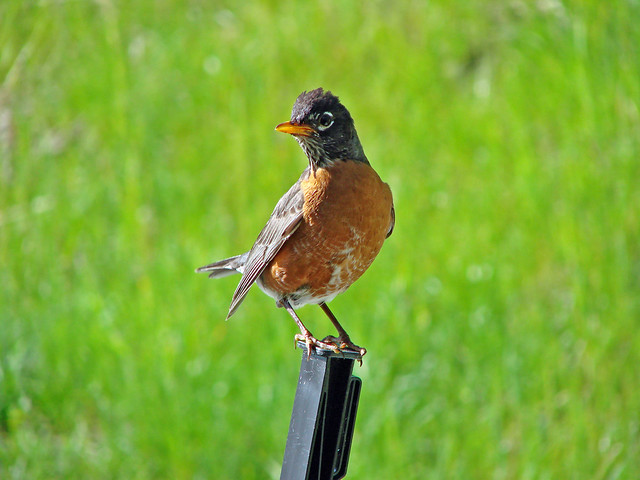
Robins and cardinals are not stupid. But during the nesting season, their territorial urge is even more powerful than their urge to eat or sleep. Defending their territory is how they ensure that there will be enough food for their babies. Ironically, the whole time a bird is fighting its reflection, it is not doing the things that will ensure its babies’ survival. It needs to eat, sing (if it’s a male), build a nest and incubate eggs (if it’s a female), and chase competitors away.
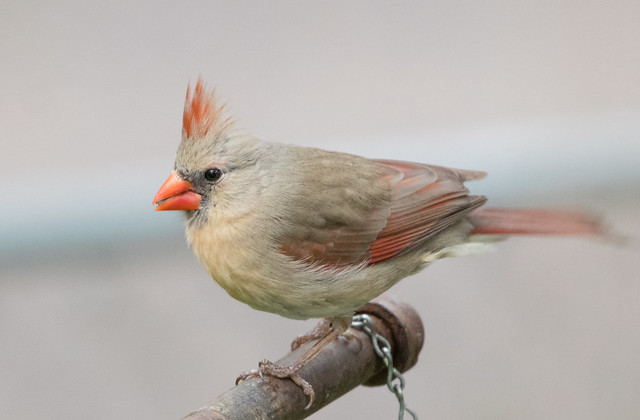
The only way to stop this destructive behavior is to break the reflection. Fortunately, you don’t have to break the window to accomplish this. The simplest way, if it’s a small window or mirror, is to tape some paper or cardboard over it, on the outside, and keep it in place for three or four days until the bird gets busy enough with other things to forget about the “intruder.” It’s harder to cover a picture window or a patio door. One technique that sometimes works is to paper over the area where the bird has been hitting and then hang shiny helium balloons nearby. Permanently covering the outside of the window with CollidEscape will both eliminate the reflection and allow you to see out. Fortunately, this behavior usually stops as soon as the clutch hatches, so no matter how you deal with it, within a week the problem is usually over.
European Starlings were introduced to the United States on March 16, 1890, in Central Park in New York City. At the time, many “naturalization societies” throughout the world were intentionally introducing various animals from one continent to another. Most of these species died out, but the introduction of starlings was a rousing success. The particular club that introduced starlings was working toward the goal of establishing in Central Park every species ever mentioned in a play by William Shakespeare, and unfortunately, Shakespeare was a better playwright than an ornithologist. In Henry IV, Part I, Hotspur says, “I’ll have a starling shall be taught to speak nothing but Mortimer.” In Shakespeare’s time, starlings were popular cage birds, thought of as “poor man’s mynahs,” because anyone could catch one for a pet, unlike their relative from India. Starlings can imitate a wide variety of sounds, but Shakespeare didn’t realize that it would be impossible to teach a starling to speak “nothing but Mortimer.” Even is a starling could be kept in a chamber that was absolutely silent except for someone droning “Mortimer” over and over, most starlings would experiment with rearranging the syllables of the word. Shakespeare made many apt observations about birds, but if he had been more knowledgeable about starlings, we wouldn’t be plagued with them today.
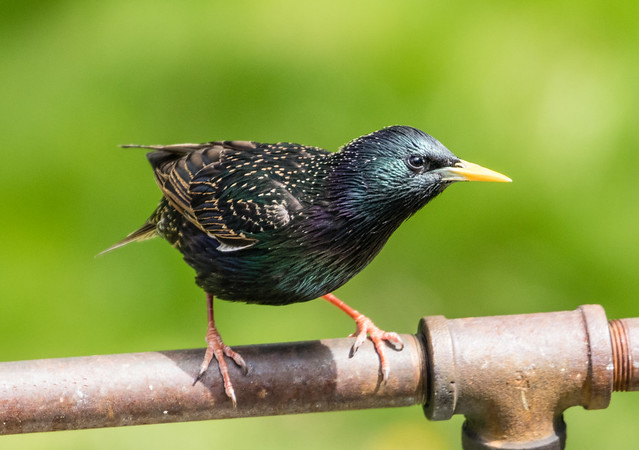
Starlings are fascinating creatures. My family had a pet starling named Mortimer for many years. He never learned to speak, but his song was a string of imitations of sounds in our home—the tea kettle, the telephone, birds heard through the window, distant lawn mowers, and even the smoke alarm. Listening to starlings outdoors, it’s often easy to figure out where individual birds have spent time by the different recognizable sounds in their repertoire. And the way flocks wheel about in unison in high-speed flight is breathtaking and amazing.
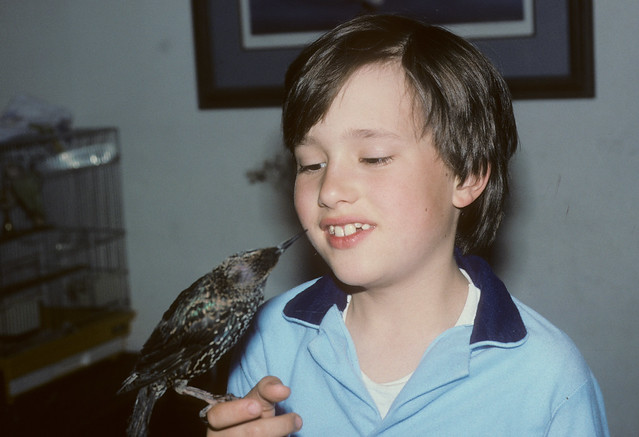
But like Rock Pigeons, starlings can be serious nuisances. Their droppings occasionally build to unhealthy levels, and their noise is a constant irritation. Unlike pigeons, starlings can also cause huge ecological problems. They are cavity nesters, appropriating nest holes from flickers, Red-headed Woodpeckers, and other larger species. Starlings are more aggressive than these other birds and have a special weapon in their beak musculature. On most songbirds, the muscles exert pressure when the birds close their beaks, allowing them to crack seed and nut shells or to break off chunks of food. Starling facial muscles are arranged to exert force as the starling pulls its beak open, allowing it to stick its beak into the soil and then open it to expose grubs and other food items beneath the surface. A starling can use the beak in a deadlier way, too. If a woodpecker alights outside a hole appropriated by a starling, the starling can stab the woodpecker and then open the beak, exacerbating the injury. Because of this aggressive nest appropriation, starlings have had a serious impact on some species, including Red-headed Woodpeckers and bluebirds.
To control starlings, it’s most important not to subsidize them. Make sure that any songbird nest boxes have holes too small for starlings to squeeze through—check with the North American Bluebird Society and the Purple Martin Conservation Association for suggestions about nest box design. If starlings are nesting on your own house, dissuade them by closing off nooks and crannies or temporarily setting up helium balloons that will float near their access points. If starlings are visiting your feeding station, it’s helpful to switch to hanging feeders, because most starlings prefer steadier footing. During midsummer days, when starling babies are fledging, close down your suet feeders.
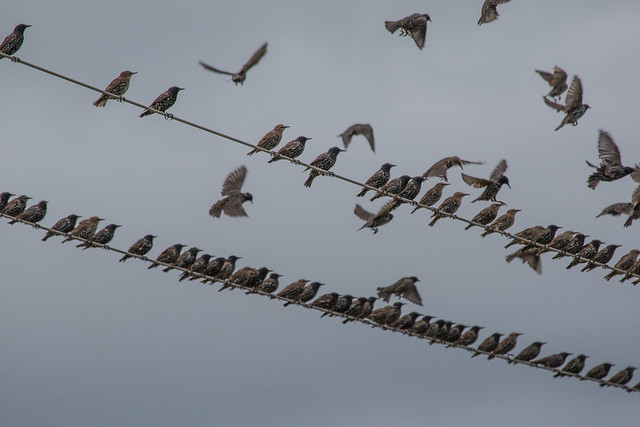
Starlings are not native, so they are not protected by the laws that protect native birds. If a starling has invaded a martin house or bluebird box, it is perfectly legal to toss out the eggs and nesting materials. In some urban and agricultural situations in which starlings are causing economic or health problems, they are doused with detergent water, usually in their roosts at night. This destroys the waterproofing and insulating value of their feathers, and they die of hypothermia. This is a horrible way for the birds to die, but at least it doesn’t hurt nontarget species or cause lasting environmental damage. Poisons are never an appropriate way to deal with starlings.
In some places, grackles, redwings, and other blackbirds have become fairly serious pests, subsidized by agriculture. Winter wheat and other crops provide food during winter, when these birds historically had their highest mortality. According to current estimates, Red-winged Blackbirds are the most abundant land bird in North America. As beautiful as they are, they can cause problems for farmers. Millions of redwings and other blackbirds are intentionally killed every year by pesticides, trapping, shooting, and roost spraying with detergent water, especially by sunflower growers. Despite this, in North and South Dakota alone, the redwing population increased about 33 percent between 1196 and 1999. Blackbirds are not the worst problems facing these farmers. Every year, sunflower growers throughout the United States lose an average of 6 percent of their crop to disease, 7 percent to insects, 5 percent to weeds, and 3 percent to waste when harvesting with combines; farmers in North and South Dakota, where the redwing problem is worst, lose only about 1 to 2 percent of their crop to birds. This sounds negligible, but a few farmers bear the brunt of the damage—every year about 500 growers lose more than 25 percent of their crops to blackbirds. Interestingly, a USDA Animal and Plant Health Inspection Service (APHIS) study estimates that despite the huge increase in the redwing population, their damage to sunflower crops has not increased at all.
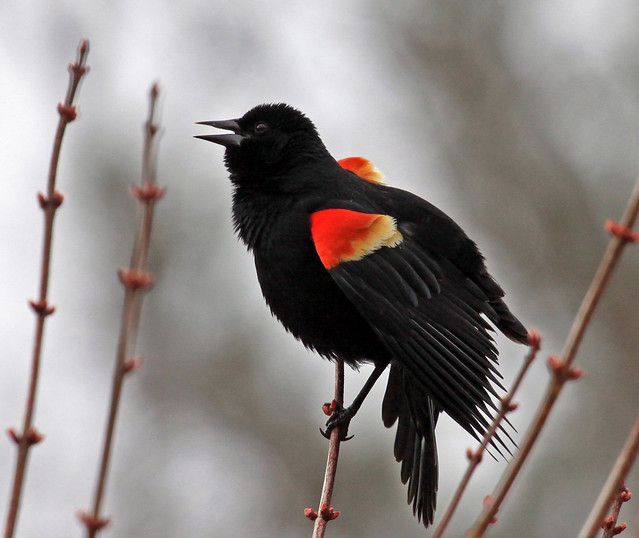
One novel plan was a 2001 proposal by APHIS to kill 6 million Red-winged Blackbirds in the Dakotas over three years by setting out poisoned rice during spring migration. Migrating birds would be lured down by the rice during the season that they feed on waste grain rather than crops so aren’t causing any damage at all. The intention was to reduce their numbers before the birds reproduced. But the proposal would have indiscriminately killed all birds attracted to the rice, including bobolinks, meadowlarks, and native sparrows, as well as any scavengers and predators that fed on the poisoned birds. Also, there was absolutely no research ascertaining that the redwings migrating through the area in spring were the same populations that caused problems in fall. As of this writing, the program hasn’t been approved. It would be much more environmentally sound and probably just as cost-effective to provide crop insurance for sunflower growers and compensate those few farmers who lose a significant portion of their crops to blackbirds.
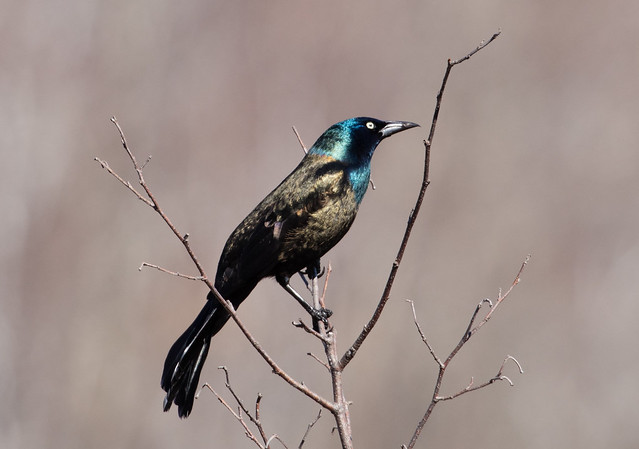
In the backyard, blackbirds aren’t nearly as troublesome as they are on farms, and birders take a lot of pleasure in visiting marshes in the spring to see redwings perched atop cattails advertising their territories. But blackbirds certainly don’t need subsidies from humans, and some species, particularly grackles, are aggressive toward smaller birds, occasionally killing them. Blackbirds prefer to feed on the ground, so when they’re abundant, don’t allow spilled seed to collect near your feeders. Switching to hanging feeders during heavy blackbird visits can reduce the problem, too. When grackles or starlings collect in my backyard, I simply let the dogs out, and the birds fly away.
Cowbirds are in the blackbird family, but they are unique among North American birds in being brood parasites. This means that rather than constructing their own nests, cowbirds lay their eggs in the nests of other birds, allowing them to incubate the cowbird eggs and raise the babies. Cowbirds hang around with their foster parents for several days after fledging but do not imprint on them. When they can find enough food on their own, they instinctively leave and start associating with other cowbirds.
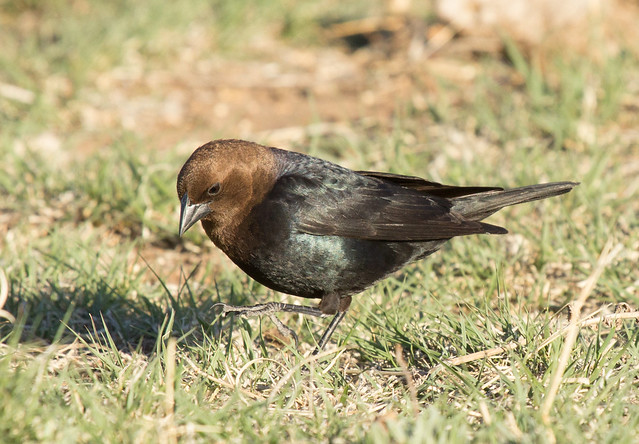
Brown-headed Cowbirds were once closely associated with bison, eating insects and seeds from the prairie soil trampled by the beasts. Because bison were nomadic, cowbirds were unlikely to parasitize the same hosts year after year, and prairie birds evolved to deal with them. Before settlement, the most significant limiting factor for cowbird populations was their dependence on the bison population. But even as humans extirpated the bison, they introduced livestock that cowbirds instinctively gravitated toward, and humans also began providing cowbirds with plenty of disturbed soil and abundant food. As a result, their population exploded, and their range expanded to areas where songbirds had never been exposed to nest parasitism before.
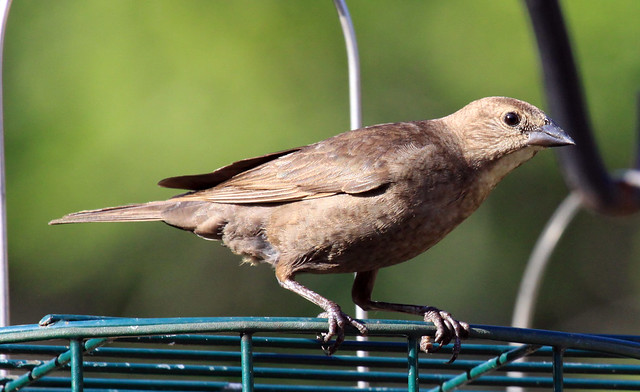
Some reports indicate that a single cowbird can lay forty or even sixty eggs in a season, although the average is probably much fewer. But clearly, a large population of cowbirds invading an area where few or no songbirds had developed strategies to deal with nest parasitism could cause grave problems. Fortunately, despite the large and sudden range expansion in the past two centuries, the cowbird population in North America is currently stabilizing or even decreasing, according to Breeding Bird Survey data.
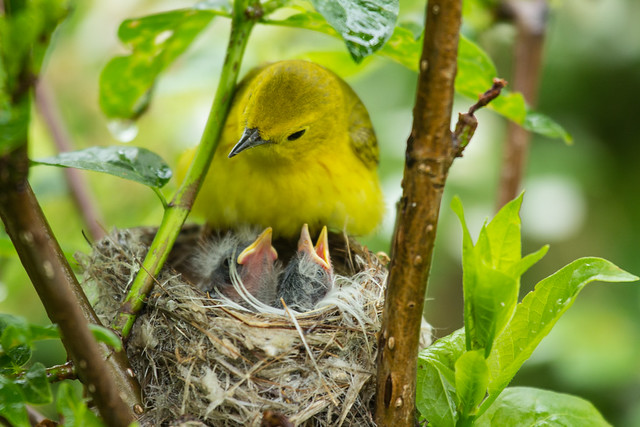
Before laying an egg, a female cowbird tosses out one of the host’s eggs, so right off the bat, a cowbird egg represents a 20 to 25 percent loss in potential reproductive success for the host birds. Baby cowbirds are not aggressive toward their foster siblings (it is European cuckoos that push other eggs and nestlings out of the nest soon after they hatch), but because female cowbirds tend to select smaller host species, baby cowbirds have an advantage. When songbird parents attend the babies, they don’t seem to recognize them individually or to remember which one has been fed most recently, so they simply stuff food into the largest, most conspicuous mouth—invariably, the cowbird’s. In years when food is abundant, most of the babies get plenty to eat, but when food is harder to come y, the cowbird’s survival comes at the expense of one, two, or even three brood mates. Margaret Morse Nice found that in addition to the lost egg, on average, one Song Sparrow nestling died for each cowbird successfully raised.
Nest parasitism may be a problem for individual broods raised with a cowbird, but overall, it has little effect on many species, including Song Sparrows and Chipping Sparrows. These fairly short-distance migrants arrive early in spring and often nest two or even three times in a season. But cowbirds can cause serious losses among neotropical migrants, which arrive later and depart sooner, generally nesting only once a season. The problem is exacerbated for endangered migrants. A full 90 percent of Black-capped Vireo nests are parasitized in open canyon woodlands in Fort Hood, Texas; 80 to 90 percent of Bell’s Vireo and Yellow-breasted Chat nests are parasitized in desert riparian habitat in the lower Colorado River valley, and 50 percent of Lazuli Bunting nests are parasitized in shrubland prairie habitat in western Montana.
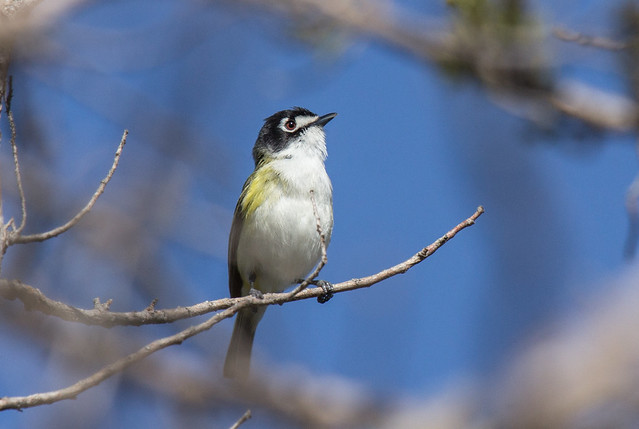
When ornithologists first made a connection between the range expansion of Brown-headed Cowbirds and the decline of endangered species such as Black-capped Vireos and Kirtland’s Warblers, they began protecting the vulnerable populations by trapping and killing cowbirds, with varying success. Now research is focused on determining just how serious the cowbird threat really is. According to Vincent Muehter in a National Audubon Society Report:
Conservationists and the public tend to overestimate the significance of parasitism as a major cause of declining songbird populations. A recent study failed to show population-level effects of cowbird parasitism on host species and refuted key predictions about impact of parasitism. This research was based on the reasonable premises that (1) host populations should decrease in areas where cowbirds are increasing, and increase in areas where cowbirds are decreasing (Breeding Bird Survey data); and (2) heavily parasitized hosts should decrease while less commonly used hosts should increase or maintain stable populations (Ontario Nest Record data).
Cowbird control programs on Endangered Species have had some success in meeting their ultimate goal: increasing local host populations. In the Least Bell’s Vireo, populations increased following cowbird control efforts and efforts to improve breeding habitat. In the Kirtland’s Warbler, cowbird control and habitat restoration combined to bring populations in Michigan back from 200 breeding pairs in 1972 to about 400 breeding pairs in 1998…However, four years of cowbird control have not helped restore Willow Flycatcher populations in California, suggesting that habitat, not cowbirds, is the key limiting factor.
Scientists suggest that cowbird control is a short-term solution that ignores the real problem of habitat degradation as a result of agriculture, grazing, and development. They cite studies showing limited geographical reach of control and those showing no long-term benefit without indefinite support. Scientists caution against diverting limited human and financial resources to cowbirds and neglecting the root causes of why species are at-risk. Scientists, however, support limited control to help restore local populations of Threatened or Endangered species.
Scientists advocate protection and restoration of host breeding habitat, and improvements in grazing and agricultural practices.
Cowbird control initiatives should answer three practical questions: (1) Does control fix the root causes driving high rates of parasitism? (2) Do the benefits outweigh the inevitable long-term financial costs? (3) Is control an effective “stop-gap” measure to keep an endangered species viable until root problems can be corrected?
Cowbirds feed in open areas and invade forests only along edges to search for nests. Forest fragmentation increases edges and thus increases the potential for cowbird parasitism, which is one more reason why defending natural areas from urban sprawl and protecting intact portions of state and national forests are so important.
House Sparrows were introduced to the United States many times during the 1800s by homesick European immigrants who missed the familiar cheeping, by religious settlers who wanted to bring to America birds mentioned in the Bible, by foolish optimists who hoped that the sparrows would feed on insect pests or the bugs and seeds in horse manure, and by many other groups. The first documented introduction that I could find was by Nicolas Pike, who released eight pairs in Green-Wood Cemetery in Brooklyn in the spring of 1850, but other releases were happening at the same time. Some towns and cities even set up friendly competitions to see which could get House Sparrows established first. The sparrow population exploded, then stabilized and even fell. Now it’s fairly stable, although sparrows have declined in some areas where House Finches have appeared. In Europe, however, House Sparrow numbers have declined dangerously.
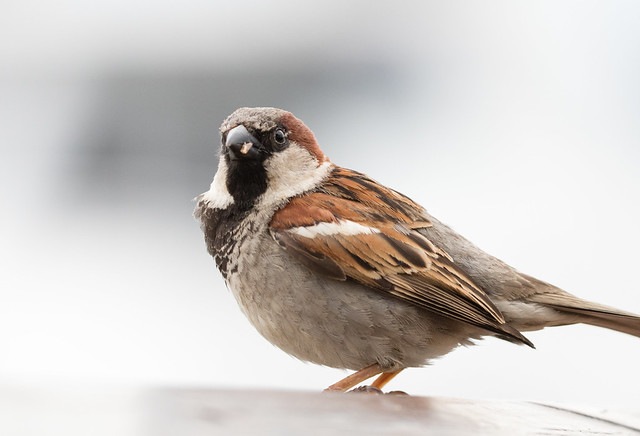
Like European Starlings, House Sparrows nest on buildings and in cavities and nest boxes. And like starlings, House Sparrows are extremely aggressive in appropriating and defending nest boxes. However, House Sparrows are small enough to fit through the entrance holes to bluebird and martin boxes and small natural cavities, which causes grave problems for these birds. House Sparrows can destroy eggs and kill nestlings and even adults of these species. So in rural and suburban areas, they pose serious threats to native bluebirds and martins. As nonnative birds, House Sparrows are not protected in the United States; eggs or nestlings can be removed from nest boxes, and adults can legally be killed.
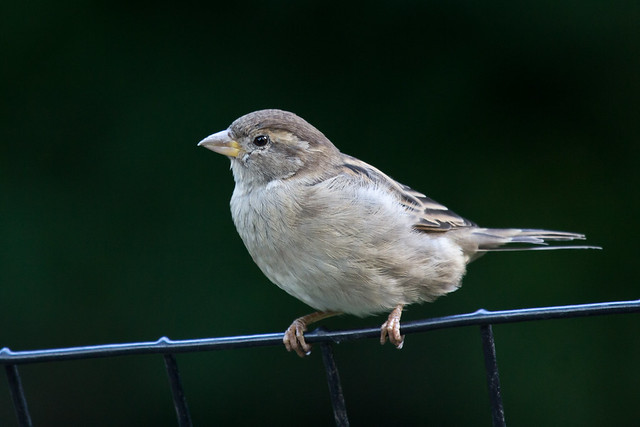
In urban areas, House Sparrows aren’t nearly so bad. They fill a niche that wouldn’t be filled by any native birds, feeding on crumbs and weed seeds and nesting in nooks and crannies of buildings. When I was a child, House Sparrows used to cheep in the shrubs beneath mu bedroom window, and I’d listen to them every night as I went to sleep, imagining the adventures they were recounting to one another. Today, I love watching how they adapt to and exploit new sources of food and warmth. At expressway rest stops, they frequently hop up to newly parked cars to snatch crushed insects from the grilles. During extreme cold snaps in northern Minnesota, I often watch them fly up to cars the moment a neighbor pulls in the driveway and turns off the engine. Before the driver even gets out of the car, several sparrows have flown under it, where they bask in the engine’s heat for many comfortable moments until it cools down. For me, these urban sparrows are as endearing as Charles Dickens’s Artful Dodger.
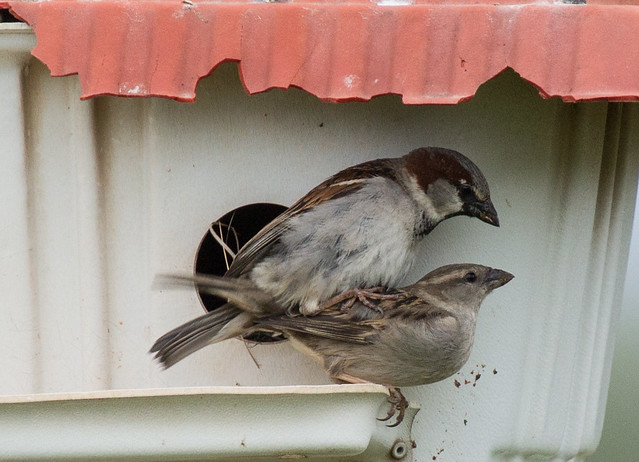
But even in urban areas, House Sparrows compete with native birds for food, especially when weary migrants are passing through. Cities are often built on rivers and lakeshores, precisely the routes that many migratory birds use. Providing at least some feeder fare that House Sparrows don’t like can help these hungry strangers passing through town.
From 101 Ways to Help Birds, published by Stackpole in 2006. Please consider buying the book to show that there is a market for bird conservation books. (Photos, links, and updated information at the end of some entries are not from the book.)